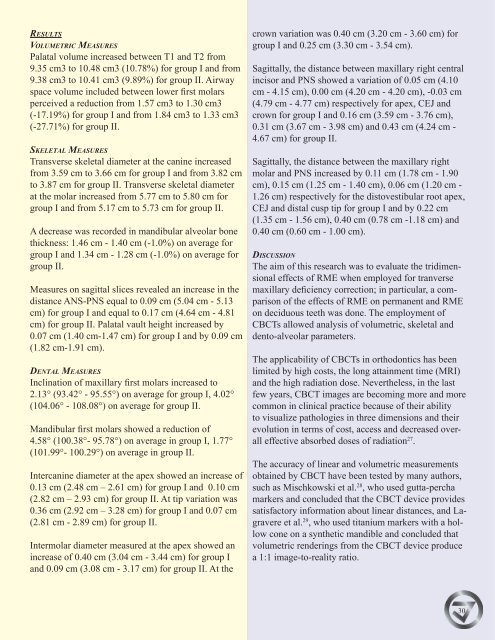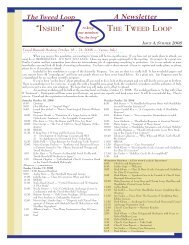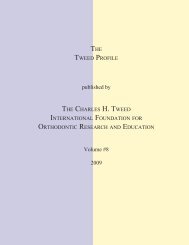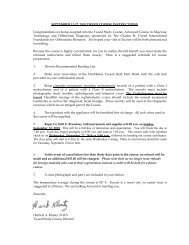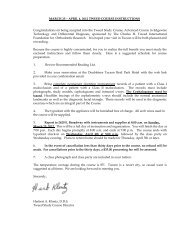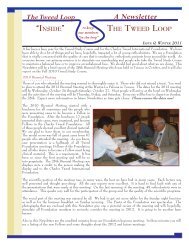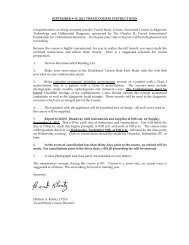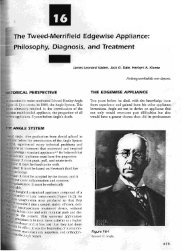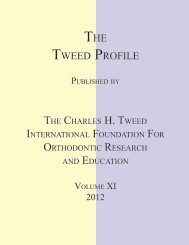the tweed profile - The Charles H. Tweed International Foundation
the tweed profile - The Charles H. Tweed International Foundation
the tweed profile - The Charles H. Tweed International Foundation
Create successful ePaper yourself
Turn your PDF publications into a flip-book with our unique Google optimized e-Paper software.
RESULTS<br />
VOLUMETRIC MEASURES<br />
Palatal volume increased between T1 and T2 from<br />
9.35 cm3 to 10.48 cm3 (10.78%) for group I and from<br />
9.38 cm3 to 10.41 cm3 (9.89%) for group II. Airway<br />
space volume included between lower first molars<br />
perceived a reduction from 1.57 cm3 to 1.30 cm3<br />
(-17.19%) for group I and from 1.84 cm3 to 1.33 cm3<br />
(-27.71%) for group II.<br />
SKELETAL MEASURES<br />
Transverse skeletal diameter at <strong>the</strong> canine increased<br />
from 3.59 cm to 3.66 cm for group I and from 3.82 cm<br />
to 3.87 cm for group II. Transverse skeletal diameter<br />
at <strong>the</strong> molar increased from 5.77 cm to 5.80 cm for<br />
group I and from 5.17 cm to 5.73 cm for group II.<br />
A decrease was recorded in mandibular alveolar bone<br />
thickness: 1.46 cm - 1.40 cm (-1.0%) on average for<br />
group I and 1.34 cm - 1.28 cm (-1.0%) on average for<br />
group II.<br />
Measures on sagittal slices revealed an increase in <strong>the</strong><br />
distance ANS-PNS equal to 0.09 cm (5.04 cm - 5.13<br />
cm) for group I and equal to 0.17 cm (4.64 cm - 4.81<br />
cm) for group II. Palatal vault height increased by<br />
0.07 cm (1.40 cm-1.47 cm) for group I and by 0.09 cm<br />
(1.82 cm-1.91 cm).<br />
DENTAL MEASURES<br />
Inclination of maxillary first molars increased to<br />
2.13° (93.42° - 95.55°) on average for group I, 4.02°<br />
(104.06° - 108.08°) on average for group II.<br />
Mandibular first molars showed a reduction of<br />
4.58° (100.38°- 95.78°) on average in group I, 1.77°<br />
(101.99°- 100.29°) on average in group II.<br />
Intercanine diameter at <strong>the</strong> apex showed an increase of<br />
0.13 cm (2.48 cm – 2.61 cm) for group I and 0.10 cm<br />
(2.82 cm – 2.93 cm) for group II. At tip variation was<br />
0.36 cm (2.92 cm – 3.28 cm) for group I and 0.07 cm<br />
(2.81 cm - 2.89 cm) for group II.<br />
Intermolar diameter measured at <strong>the</strong> apex showed an<br />
increase of 0.40 cm (3.04 cm - 3.44 cm) for group I<br />
and 0.09 cm (3.08 cm - 3.17 cm) for group II. At <strong>the</strong><br />
crown variation was 0.40 cm (3.20 cm - 3.60 cm) for<br />
group I and 0.25 cm (3.30 cm - 3.54 cm).<br />
Sagittally, <strong>the</strong> distance between maxillary right central<br />
incisor and PNS showed a variation of 0.05 cm (4.10<br />
cm - 4.15 cm), 0.00 cm (4.20 cm - 4.20 cm), -0.03 cm<br />
(4.79 cm - 4.77 cm) respectively for apex, CEJ and<br />
crown for group I and 0.16 cm (3.59 cm - 3.76 cm),<br />
0.31 cm (3.67 cm - 3.98 cm) and 0.43 cm (4.24 cm -<br />
4.67 cm) for group II.<br />
Sagittally, <strong>the</strong> distance between <strong>the</strong> maxillary right<br />
molar and PNS increased by 0.11 cm (1.78 cm - 1.90<br />
cm), 0.15 cm (1.25 cm - 1.40 cm), 0.06 cm (1.20 cm -<br />
1.26 cm) respectively for <strong>the</strong> distovestibular root apex,<br />
CEJ and distal cusp tip for group I and by 0.22 cm<br />
(1.35 cm - 1.56 cm), 0.40 cm (0.78 cm -1.18 cm) and<br />
0.40 cm (0.60 cm - 1.00 cm).<br />
DISCUSSION<br />
<strong>The</strong> aim of this research was to evaluate <strong>the</strong> tridimensional<br />
effects of RME when employed for tranverse<br />
maxillary deficiency correction; in particular, a comparison<br />
of <strong>the</strong> effects of RME on permanent and RME<br />
on deciduous teeth was done. <strong>The</strong> employment of<br />
CBCTs allowed analysis of volumetric, skeletal and<br />
dento-alveolar parameters.<br />
<strong>The</strong> applicability of CBCTs in orthodontics has been<br />
limited by high costs, <strong>the</strong> long attainment time (MRI)<br />
and <strong>the</strong> high radiation dose. Never<strong>the</strong>less, in <strong>the</strong> last<br />
few years, CBCT images are becoming more and more<br />
common in clinical practice because of <strong>the</strong>ir ability<br />
to visualize pathologies in three dimensions and <strong>the</strong>ir<br />
evolution in terms of cost, access and decreased overall<br />
effective absorbed doses of radiation 27 .<br />
<strong>The</strong> accuracy of linear and volumetric measurements<br />
obtained by CBCT have been tested by many authors,<br />
such as Mischkowski et al. 28 , who used gutta-percha<br />
markers and concluded that <strong>the</strong> CBCT device provides<br />
satisfactory information about linear distances, and Lagravere<br />
et al. 29 , who used titanium markers with a hollow<br />
cone on a syn<strong>the</strong>tic mandible and concluded that<br />
volumetric renderings from <strong>the</strong> CBCT device produce<br />
a 1:1 image-to-reality ratio.<br />
30


